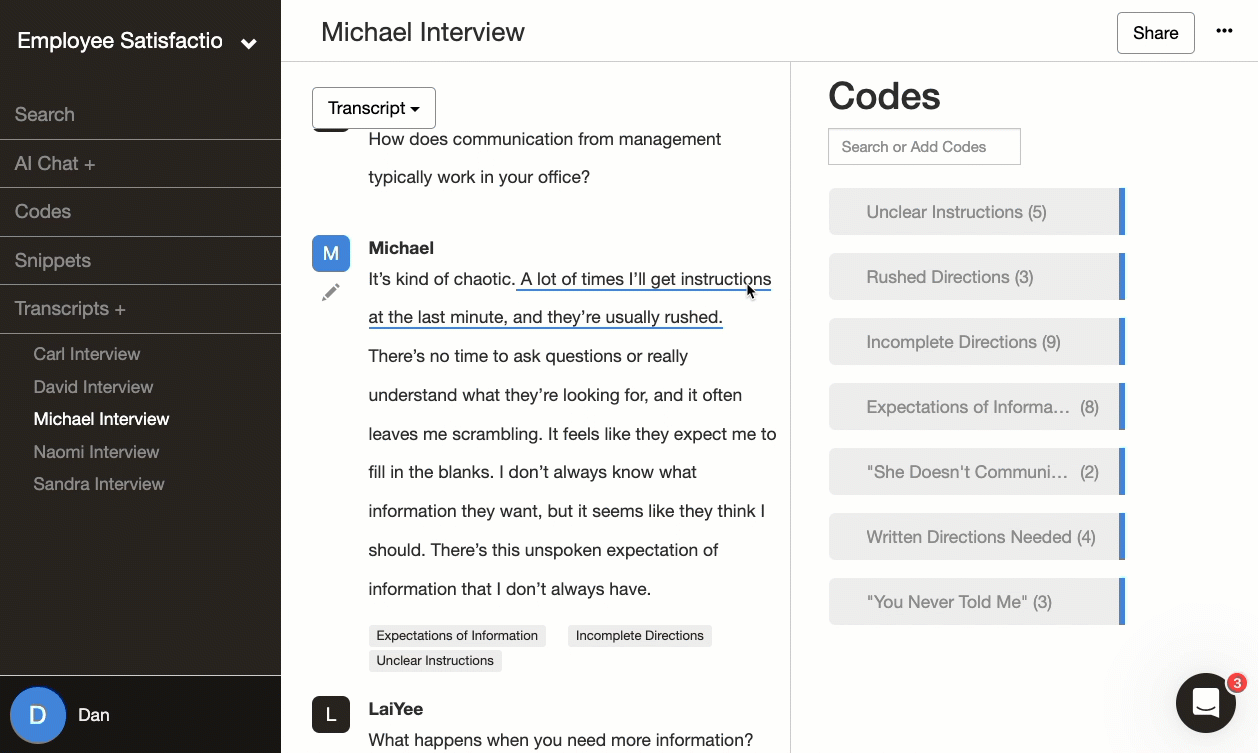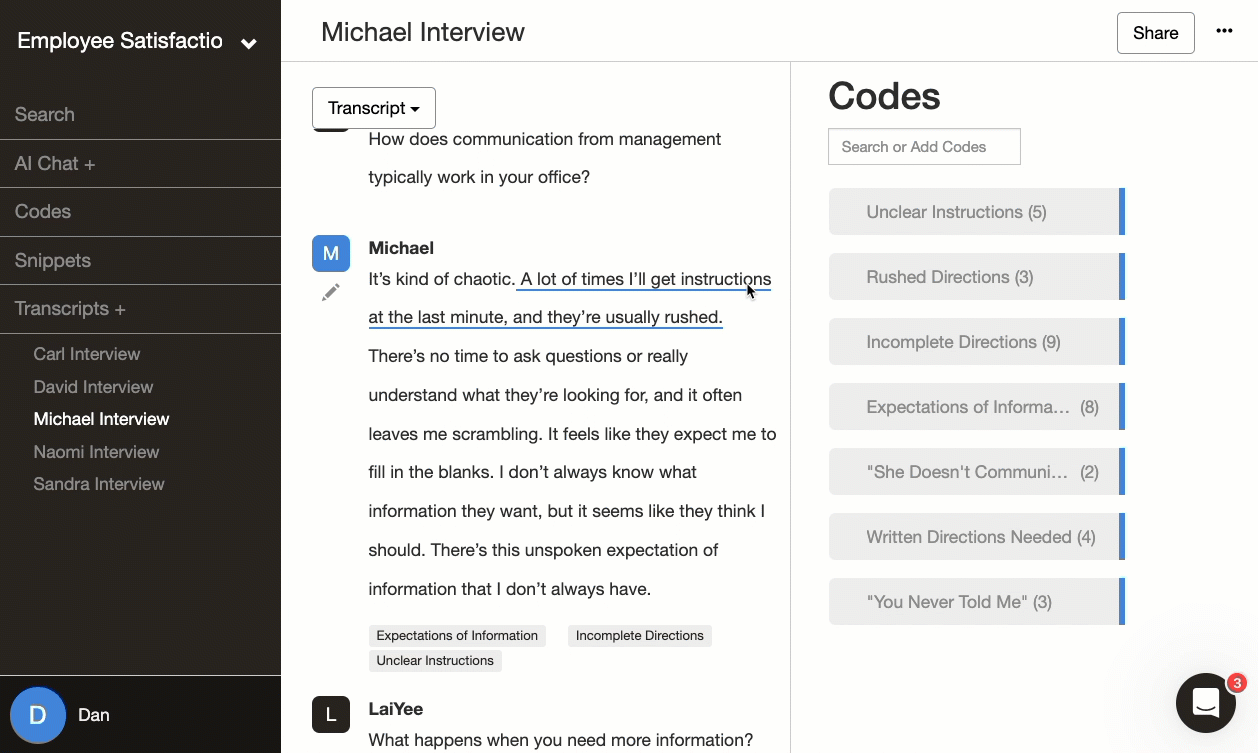How to Do Pattern Coding in Qualitative Research
Pattern coding is all about weaving the mess of your initial coding rounds into broader categories or themes, like sorting a list of your favorite songs into playlists by mood or genre.
In the aftermath of initial coding, you’re often left drowning in a sea of separate codes and side notes. Pattern coding helps you package all these loose ideas and tell a story to explain what it all means in your write up.
While “packaging” your initial code might sound easy enough, a lot of intentional decisions go into deciding when, where, and how to draw your dividing lines. Pattern coding offers a proven framework for this process.
This article walks you through pattern coding, how to avoid common roadblocks, and how tools like Delve computer-assisted qualitative data analysis software (CAQDAS) set you up for more efficient and rigorous pattern coding results.
💡 Are you just beginning with qualitative analysis and coding? Consider starting with The Practical Guide to Qualitative Analysis – or take our Free Qualitative Analysis Course for Beginners.
Pattern Coding: A Key Step in Qualitative Analysis
As a new researcher diving into qualitative analysis, you'll encounter various coding techniques. Pattern coding is a primary method that helps you make sense of your initial study findings and develop deeper insights.
Understanding Where Pattern Coding Fits in the Qualitative Coding Process
Qualitative coding involves labeling and organizing non-numerical data like interviews or focus groups. Johnny Saldaña outlines a two-part process in "The Coding Manual for Qualitative Researchers" (2015), with pattern coding taking place in the second part of the process.:
1. Initial coding (first-cycle): This is your first pass through the data. It is usually fast and loose, breaking into manageable chunks that are easier to work with.
Learn About First-Cycle Coding
- In vivo coding: Using participants' own words as codes.
- Structural coding: Coding based on specific research questions.
- Process coding: Identifying actions or processes in the data.
- Open coding: Breaking data into discrete parts for analysis.
2. Pattern coding (second-cycle): Now, you “re-code” and synthesize your initial codes to identify larger themes, concepts, or categories.
Your first-cycle methods break down piles of raw data into manageable parts. But to dive deeper into meaning and identify broader patterns across your data, you’ll need to take it a step further with second-cycle methods like pattern coding.
What is Pattern Coding in Qualitative Research?
With your messy initial coding complete, pattern coding is the next stage where you’re re-coding and creating “meta-codes.” You’re looking to understand more about existing data like how existing codes relate to each other and why those relationships occur.
The goal of pattern coding is to:
Identify connections between your initial codes
Group related ideas
Eliminate redundancy
Develop richer, more cohesive results
Your pattern codes ultimately bridge initial codes to your final analysis, making it easier to lay out and explain in your final write up or thesis.
⏳ Coding Tip: Saldaña specifically suggests using CAQDAS for pattern coding instead of manual techniques like pen and paper, Microsoft Word, or Excel. Delve offers features like data filtering, drag-and-drop coding, and visualization tools that help you develop richer pattern codes in less time without all the organizational bottlenecks.
Basic Pattern Coding Workflow
With pattern coding, you move from labeling specific details to spotting broader themes that come together in the data.
Start with your batch of first-cycle codes, possibly dozens or even hundreds.
Cluster these codes into smaller categories based on patterns you find (more on this soon).
Develop "meta-codes" or pattern codes that capture the essence of these categories. You’re transitioning from specific details and zooming out to spot larger themes or ideas that pool together.
Use these pattern codes to construct the narrative of your study.
Think of pattern coding like you’re zooming out from inside the maze of initial codes to look at things from a birds-eye view.
QUICK EXAMPLE OF PATTERN CODING
Saldaña’s book offers a simple pattern coding example that starts with a batch of initial codes collected from staff interview transcripts.
First-Cycle Codes
- • Unclear Instructions
- • Rushed Directions
- • Incomplete Directions
- • Expectations of Information
- • "She Doesn't Communicate"
- • Written Directions Needed
- • "You Never Told Me"
The next image shows how easy it is to drag, drop, mix, and match codes to create this pattern code in Delve:

In a few clicks, these initial codes have been grouped under the more inferential pattern code of "Dysfunctional Direction".
⚠️ Try not to oversimplify. Pattern codes should be specific enough to be meaningful, but broad enough to capture a pattern across data. "Communication Issues" is too broad. "Dysfunctional Direction" gives additional insight.
When to Use Pattern Coding
That brings us to when you should actually use pattern coding in a qualitative research project. Beyond just organizing your data, it’s particularly useful when you need to:
Go Beyond Surface-Level Analysis: To uncover hidden patterns or relationships in your data. For grounded theory or thematic analysis, pattern coding connects the analytical dots in less obvious ways. In our earlier example, instead of just grouping complaints, it could have helped flesh out "Dysfunctional Direction" as a deeper communication issue within the office.
Identify Underlying Causes: Understanding the reasons behind certain behaviors or trends is hard. Imagine trying to find the main plot across hundreds of different news articles in content analysis. Pattern coding moves you from simply categorizing data to interpreting its deeper meaning. Going back to "Dysfunctional Direction," this pattern code pointed to a systemic communication issue rather than just isolated complaints.
CRASH COURSE | IDENTIFYING UNDERLYING CAUSES
John: "I often get unclear instructions from my manager, and they're always rushed. It’s hard to know exactly what they want, and I end up feeling lost."
Emily: "Sometimes, I don’t get the full details and have to ask for incomplete directions to be clarified."
Ben: "There's this unspoken expectation of information that I should just know, even though they never tell me everything upfront."
Initially Coded Data:
- Unclear Instructions
- Rushed Directions
- Incomplete Directions
- Expectation of Information
Pattern Code:
Dysfunctional Direction — These individual complaints initially seemed disconnected, but pattern coding led the team to a broader systemic issue in how management delivered instructions. This showed the communication problems were part of a larger pattern affecting the organization and not isolated incidents.
Reveal Complex Relationships: Study multiple variables or intricate relationships. Pattern coding can help you clarify how these elements interact and influence each other. If you’re conducting discourse analysis for example, you might find that informal chats combined with frequent meetings strengthen workplace relationships more than either one alone.
Develop More Rigorous Insights: If you’re aiming to refine your analysis and draw out more sophisticated conclusions, pattern coding helps you distill the data into fully interconnected ideas. In our example, you could use it to show how different communication channels work together to impact overall team productivity.
Enhance Collaboration: When working in a team, pattern coding keeps everyone on the same page by standardizing how data is categorized and interpreted. Learn how to do better collaborative qualitative analysis with Delve.
Creating pattern codes is really all about finding deep-seated connections between your data. In our example, pattern coding turned individual complaints into a clear systemic issue. Pattern coding can be used any time you need to dig for these deeper insights in your scattered initial analysis.
⏳ Coding Tip: With Delve, you can create customizable code hierarchies to group related codes and track their evolution over time. This feature ensures your pattern coding stays flexible and scalable as your analysis progresses.
How to Create Pattern Codes
But when it comes time to get to work, how do you actually create your pattern codes?
While there's no one-size-fits-all method, Saldaña suggests focusing on three main concepts to guide your pattern-seeking process: themes, explanations, and relationships among people or groups. Think of these as different lenses to cluster and interpret your codes.
Concepts For Clustering Codes in Meaningful Ways:
- Themes: Organizing data into broader topics that recur throughout your dataset.
- Explanations: Providing insights into the causes behind your observations.
- Relationships Among People or Groups: Examining social networks and patterns of interaction in your research.
Core Concepts For Creating Pattern Codes
Let's walk through each concept in more detail, using clear examples to illustrate how you might apply them in your own pattern coding.
1. THEMES
What They Are: Themes are big ideas or topics that appear repeatedly throughout your data. They help you categorize your findings into coherent groups that capture the essence of what's being discussed.
Example: Suppose you're analyzing interviews about employee satisfaction in the workplace. Some of your initial codes might be:
"Flexible Hours"
"Work-Life Balance"
"Supportive Management"
"Career Advancement"
"Positive Work Environment"
You might cluster these codes under the theme "Job Satisfaction Factors." Learn more about generating themes here:
⚠️ Best Practice: Remember not to oversimplify. Themes should be specific enough to be meaningful. Instead of a vague theme like "Good Stuff," use something more descriptive like "Job Satisfaction Factors."
2. EXPLANATIONS
What They Are: Explanations offer reasons behind what you're observing in your data. They help you understand causes and answer "why" questions.
Example: Continuing with the workplace study, suppose you notice codes like:
"Unclear Instructions"
"Lack of Feedback"
"Micromanagement"
“You Never Told Me”
"High Turnover"
This is where you might develop an explanation pattern code such as “Dysfunctional Direction,” which helps explain why employees are experiencing dissatisfaction or frustration. Another option would be "Ineffective Leadership Practices."
💡 Best Practice: Focus on identifying the underlying causes behind your data. A good explanation code should go beyond what’s happening to answer why it’s happening, offering deeper insight into patterns of behavior or trends.
3. RELATIONSHIPS AMONG PEOPLE OR GROUPS
What They Are: This concept focuses on how individuals or groups interact and influence each other within your research context. It highlights social dynamics and networks significant in your data.
Example: From your interviews, you might have codes like:
"Team Collaboration"
"Mentorship Programs"
"Peer Support"
"Interdepartmental Conflicts"
You could create a pattern code "Workplace Relationships" to explore how these interactions impact the work environment. Or, you might develop more specific pattern codes like "Supportive Team Dynamics" or "Communication Barriers Between Departments," depending on what your data reveals.
💡 Best Practice: Focus on how people or groups interact and affect each other. Look for patterns that show how these relationships impact the overall dynamic, whether through teamwork, communication, or influence.
By using these three concepts to cluster your scattered observations into these bigger analytical buckets, you're not just organizing your mess of data – you're revealing connections and letting that data tell a larger story. Next, we’ll walk through an example to show exactly how pattern coding works in practice!
Pattern Coding Example
Let's tie all this together with a step-by-step example of pattern coding. We’ll focus on how Saldaña developed the pattern code "Dysfunctional Direction" we used earlier, and how this process leads towards a deeper understanding of what's going on the data.
1. Review your initial codes
Start by reviewing your first-cycle codes from staff interviews. In our example, these included:
First-Cycle Codes: Employee Satisfaction Study
Code: Unclear Instructions
Description: Vague directives leading to confusion and errors.
Code: Rushed Directions
Description: Hastily conveyed information causing misunderstandings.
Code: Incomplete Directions
Description: Instructions are incomplete, requiring clarification.
Code: Expectation of Information
Description: Assumption that employees should know missing details.
Code: She Doesn't Communicate
Description: Leadership is perceived as not communicating enough.
Code: Written Directions Needed
Description: Requests for written instructions to clarify verbal ones.
Code: You Never Told Me
Description: Frustration caused by perceived information gaps.
You want to read through these codes several times, noting any initial thoughts or connections. Keeping analytical memos is a great way to keep track of your thought process and develop ideas.
⏳ Coding Tip: Attaching memos to your initial codes helps capture thoughts and develop your pattern codes. Delve links memos directly to codes, making it easier to reel in scattered ideas and keep your thought process on track.
2. Group similar codes
Now you start clustering your codes to identify possible "meta-codes;" the patterns, trends or commonalities you think matter most.
At this stage, you want to ask yourself questions like:
Which codes show up frequently?
Do some codes relate to the same idea?
Is there a common underlying issue?
Many of the initial codes seem to relate to communication problems, particularly about information coming from management. At this stage you might notice that codes like "You Never Told Me" and "Rushed Directions" often appear together. This co-occurrence can hint at a larger issue.
As you group codes, keep recording memos about your thoughts and decisions. These memos help you track the development of your pattern codes. For example, you might write:
"The recurring theme of unclear and incomplete instructions ("You Never Told Me," "Rushed Directions") suggests a pattern of 'Dysfunctional Direction,’ meaning management consistently fails to provide clear communication, leading to employee frustration."
⏳ Coding Tip: CAQDAS like Delve offer data filtering, drag-and-drop coding, and data visualization tools, all features that make it more time-efficient to uncover these underlying connections.
3. Define pattern codes
Now, you actually assign a pattern code (or "meta-code") to those clusters that captures something important about your data.
When creating your pattern codes, you’re using the trio of options Saldaña suggests: themes, explanations, and relationships among people or groups. For Dysfunctional Direction:
Pattern Code: Dysfunctional Direction
Description: This pattern code synthesizes several complaints to identify a systemic issue with leadership and communication in the workplace.
Code: Unclear Instructions
Description: Vague directives leading to confusion and errors.
Code: Rushed Directions
Description: Hastily conveyed information causing misunderstandings.
Code: Incomplete Directions
Description: Instructions are incomplete, requiring clarification.
Code: Expectation of Information
Description: Assumption that employees should know missing details.
Code: She Doesn't Communicate
Description: Leadership is perceived as not communicating enough.
Code: Written Directions Needed
Description: Requests for written instructions to clarify verbal ones.
Code: You Never Told Me
Description: Frustration caused by perceived information gaps.
4. Iterate and refine
Continuously review and adjust your codes. Go back over your pattern codes to confirm they reflect your data. This might involve:
Re-assessing Data Segments: Confirm that each initial code fits well within the pattern code and isn’t repeating ideas.
Seeking Feedback: Discuss your findings with colleagues through peer debriefing or team members for additional perspectives.
Adjusting as Needed: You might find that some codes fit better elsewhere. For instance, "Expectations of Information" might work better under a different pattern code like "Lack of Transparency."
💡 Best Practice: Keep a log of your coding decisions and changes in your memos. This audit trail helps maintain the rigor of your analysis and can be invaluable when writing up your findings.
5. Visualize relationships & patterns
In this final step, map out how all your patterns connect. Go back to your diagrams or matrices to visually represent relationships between your pattern codes.
This step helps identify complex interactions and potential areas for further investigation. You can explore data segments where "Dysfunctional Direction" co-occurs with other pattern codes like "Employee Morale" or "Project Delays." This type of pattern could help reveal other ways that communication issues are affecting other parts of the workplace
💡 Best Practice: Create a visual representation of your codes, such as a co-occurrence matrix, mind map, or clustered sticky notes written out by hand. This can help you identify relationships and groupings without getting overwhelmed.
For Example:
- Find Co-occurrences: Where do "Dysfunctional Direction" and "Employee Morale" appear together?
- Explore Alternatives: Identify segments where either "Dysfunctional Direction" or "Project Delays" are coded.
- Exclude Irrelevant Data: Focus on segments with "Dysfunctional Direction" but not "Employee Satisfaction."
As you go through this process, you're organizing what will likely become the cornerstone of your final results. That will include explaining and referencing the matrices or note cards or any other tools that you’ve used along the way. Remember, pattern coding is an iterative process. You'll refine your codes several times, each pass deepening your understanding of the data. While it can be time-consuming, the insights gained make it a key step in qualitative analysis.
⏳ Delve Tip: Delve’s filtering tools make it easy to focus on specific segments. For example, find where "Dysfunctional Direction" overlaps with "Employee Morale," or identify sections with "Project Delays" but no mention of "Leadership Issues." Use "and," "or," and "not" to fine-tune your search and uncover deeper insights.
Challenges and Tools for Pattern Coding
Pattern coding is a powerful tool that requires synthesizing and organizing insights from your initial coding phase. However, grouping codes, avoiding oversimplification, managing complex relationships between codes, and determining the right time to transition from initial coding can cause a lot of issues.
❌ Challenges with Pattern Coding
At this secondary stage of analysis, pattern coding can be both powerful and tricky. The goal is to weave together data in a way that enhances your overall narrative without losing sight of important details. Common roadblocks include:
Grouping Codes Effectively: Figuring out how to group codes in the most meaningful way can feel like piecing together a complex puzzle. Missteps here can obscure valuable insights or lead to irrelevant groupings.
Risk of Oversimplifying: When combining codes into broader themes, there’s a danger of watering down the nuances within the data. Oversimplification can flatten the richness of your findings, causing you to miss out on key subtleties.
Managing Complex Relationships: It’s not just about connecting the dots between individual codes—it's about keeping track of how these codes relate to each other. This is where things get messy if you're not using the right tools to manage complex relationships within the data.
Knowing When to Start: Jumping into pattern coding too early—or stopping your initial coding phase prematurely—can result in a shallow analysis. You need a solid foundation of first-cycle codes before diving deeper into pattern identification.
Given these challenges, finding the right tools to support your pattern coding process is essential. Let’s explore some options that can help you navigate this creative yet complex stage of analysis.
💡 Coding Tip: Delve offers a range of features to help you navigate pattern coding challenges:
- Data Filtering: Use logical operators like "and," "or," and "not" to focus on co-occurrences or exclude irrelevant data.
- Visualize Relationships: See how different codes interact with data visualization tools to manage complex relationships.
- Drag-and-Drop Coding: Organize and group codes quickly, refining them as your analysis evolves.
- Memos and Notes: Attach memos to codes to track your reasoning and keep everything organized.
- Collaborative Features: Work with your team in real time to stay aligned throughout the process.
Tools for Pattern Coding
When it’s time to tackle pattern coding, the right tools can make all the difference. While we’ve touched on some ways CAQDAS can enhance your process, there are other options to consider depending on your workflow.
1. PEN AND PAPER
Using highlighters and sticky notes is a great start. You may find writing out codes on notecards helps you quickly compare different clustering techniques. However, this method can be messy and quickly gets unwieldy if you have a large amount of separate codes to deal with.
- Using notecards or a visual tool helps you quickly move and reorder codes all within eyesight.
❌ Challenges:
- Difficult to reorganize or group codes as new patterns emerge
- Limited space for writing detailed explanations of pattern codes
- Near-impossible to efficiently track relationships across multiple data sources
2. WORD DOCUMENTS
Word processors like Microsoft Word are another option. They let you add comments and memos directly to your transcripts. While this approach might appear more flexible than pen and paper, it’s quite challenging for pattern coding where you’re moving in and out of dozens or hundreds of separate codes.
- Adding comments and memos to your pattern codes helps you keep track of your decisions.
❌ Challenges:
- Updating or merging pattern codes across multiple documents is time-consuming and error-prone
- Difficult to visualize relationships between codes and emerging patterns
- Limited ability to track the evolution of pattern codes over time
3. EXCEL SHEETS
Excel and other spreadsheet programs have some benefits compared to pen and paper or word processors. They can track codes and generate basic statistics when properly configured. However, their rigid structure can hinder the flexible, exploratory nature of pattern coding.
- You can track codes and generate basic stats to help you monitor code usage and identify possible patterns.
❌ Challenges:
- Rigid format can hinder the fluid nature of pattern coding
- Difficult to capture complex relationships between codes and patterns
- Limited support for transitioning to more advanced analytical stages
4. QUALITATIVE ANALYSIS TOOLS
Recognizing the limitations of traditional methods, specialized CAQDAS tools like Delve offer features tailored to the pattern coding process. Delve stands out for this process by providing:
Flexible Code Organization: Easily drag, drop, group, merge, and reorganize codes as you develop patterns.
Visualization of Relationships: Generate simple co-occurrence matrices that provide clear overviews of how codes and patterns are distributed across your dataset.
Flexible Data Views: Delve’s intuitive interface lets you filter, merge, and split codes dynamically, giving you more control as your analysis evolves from initial coding to pattern recognition.
Collaborative Features: Real-time collaboration capabilities for team-based analysis. including the option to hide others work to avoid outside influence on your coding or to compare team members code side by side.
While traditional methods may seem accessible at first, they often fall short as your pattern coding becomes more complex. Manually sorting through hundreds of codes or sprawling excel sheets can take weeks, and you’ll often miss key patterns in the data. This is a common issue if you rely on outdated methods like Microsoft Word, Excel or pen and paper.
Do these issues sound familiar? Enter Delve: a powerful pattern coding alternative, providing the flexibility and functionality needed to conduct effective pattern coding and develop meaningful insights from your data.
The Best Tool For Pattern Coding: Delve
Pattern coding is designed for connecting analytical dots and distilling scattered codes. However, like most qualitative methods, it comes with the challenges we’ve covered: picking how to group codes, avoiding oversimplification, and managing relationships between codes all present potential hurdles – among others.
With Delve, you eliminate huge parts of these issues right away. You can quickly organize, rearrange, tag, and visualize your codes, ensuring every insight is captured and connected. Whether you are working solo or part of a team, you’re able to dig deeper into your data with Delve.
Last Word on Pattern Coding
Pattern coding helps you turn dozens or even hundreds of scattered codes and ideas into coherent themes. It accelerates theory development and reveals hidden connections. However, its true potential is unlocked when paired with the right coding tools.
By simplifying organization, enhancing collaboration, and providing powerful visualization tools, Delve empowers you to extract even richer and more meaningful insights from your data – with unprecedented ease and precision.
References
Saldana, Johnny (2009). The Coding Manual for Qualitative Researchers. Thousand Oaks, California: Sage.
Braun, V., & Clarke, V. (2021). Thematic Analysis: A Practical Guide. Sage Publications.
Cite this blog post:
Delve, Ho, L., & Limpaecher, A. (2024, October 21). How to do Pattern Coding in Qualitative Research. Practical Guide to Grounded Theory. https://delvetool.com/blog/pattern-coding











